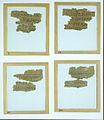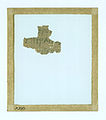Papyrus 62
| New Testament manuscript | |
| Name | Papyrus Osloensis 1661 |
|---|---|
| Text | Gospel of Matthew † |
| Date | 4th century |
| Script | Greek-Coptic |
| Found | Egypt |
| Now at | University of Oslo |
| Cite | L. Amundsen, Christian Papyri from the Oslo Collection, Symbolae Osloenses 24 (1945), pp. 121-147. |
| Size | 6.5 cm x 5.6 cm |
| Type | Alexandrian text-type |
| Category | II |
Papyrus 62 (in the Gregory-Aland numbering), signed by 𝔓62, known also as ‘‘Papyrus Osloensis’’, is a copy of the New Testament and Septuagint in Greek-Coptic. It is a papyrus manuscript of the Gospel of Matthew and Book of Daniel. The manuscript palaeographically has been assigned to the 4th century.
Description
The surviving text of Matthew are verses 11:25-30, they are in a fragmentary condition. It contains also fragments of Book of Daniel 3:51-53 and Odae (Papyrus 994 Rahlfs). Survived fragments of 13 leaves.
The text is written in one column per page, 7 lines per column, 7-12 letters in line.
- Greek
Matthew 11:25; 11:25; 11:25-26; 11:27; 11:27; 11:27-28; 11:28-29; 11:29-30; 11:30.
- Coptic
The nomina sacra are written in an abbreviated way (θς, ις, κε, πρ, πηρ, υς).
It has diaeresis over letter ypsilon.
Greek text of Matthew
εν εκεινω τω καιρω̣ αποκριθεις̣ ειπεν ο ε̣υ κ̅
νου και της γ̣η̣ς οτι εγρ̣υ̣ψας ταυα̣ απο σο ν̣ απ
αυτα νηπιοις ναι ο πη̅ρ οτι ουτως ευδοκι̣ –
παντα μοι παρεδοθη υπο̣ του π̣α̣τ̣ο̣ς̣ μ̣ο̣υ̣ –
ον ει μη ο πατηρ ουδε το πατερα τ π̣ιγινω –
αποκαλυψαι δ̣ε̣υτε προς μ̣ε παντε κοπιον̣ –
υσω υμας α̣ρατε τον ζ̣υ̣ν μου εφ̣ α̣ς̣ και μ̣α –
πεινος τ̣η κδ̣ια και ευη̣σ̣ε̣τε αν̣υ̣σιν ταις – –
και τ̣ο φορτιον μου ελα̣ν εστιν
The Greek text of the Gospel of Matthew is a representative of the Alexandrian text-type. Aland placed it in Category II.
In Matthew 11:25 it reads εκρυψας along with Codex Sinaiticus, Vaticanus, Bezae, minuscule 33, lectionary 2211. Other manuscripts read απεκρυψας (C, L, W, Θ f1, f13, Byz).
The text of Daniel represents Theodotion's recension.
History
Leiv Amundsen dated the manuscript to the 4th century. INTF dated it to the 4th century.
The manuscript was found in Egypt.
The text was published by Amundsen in 1945. It was examined by Maldfeld, Kurt Treu, Karl Jaroš.
It is cited in critical editions of the New Testament (NA26, NA27).
It is currently housed at the University of Oslo Library (Inv. 1661) in Oslo.
Image gallery
-
Mat 11.25-30 recto 1 3 5 7
-
Mat 11.25-30 verso 18 20 22 24
-
Mat 11.25-30 recto 25
-
Mat 11.25-30 recto 17 19 21 23
-
Mat 11.25-30 verso 10 12 14 16
-
Mat 11.25-30 verso 26
-
Mat 11.25-30 recto 9 11 13 15
-
Mat 11.25-30 verso 2 4 6 8
See also
References
- ^ a b c d e f g Kurt Aland, Hans-Udo Rosenbaum, Repertorium der griechischen christlichen Papyri, Walter de Gruyter, 1976, p. 54.
- ^ a b c Aland, Kurt; Aland, Barbara (1995). The Text of the New Testament: An Introduction to the Critical Editions and to the Theory and Practice of Modern Textual Criticism. Erroll F. Rhodes (trans.). Grand Rapids: William B. Eerdmans Publishing Company. p. 100. ISBN 978-0-8028-4098-1.
- ^ NA26, p; 28.
- ^ LDAB
- ^ "Liste Handschriften". Münster: Institute for New Testament Textual Research. Retrieved 7 April 2011.
Further reading
- Leiv Amundsen, Christian Papyri from the Oslo Collection, Symbolae Osloenses 24 (Oslo: 1945), pp. 121–147.







